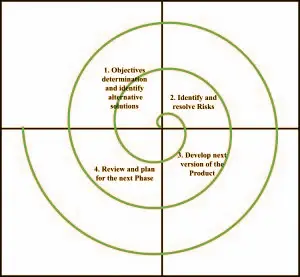The spiral model was developed by Boehm and is a software development process that blends the iterative characteristics of prototyping with the controlled and systematic nature of the linear sequential model. This approach enables quick software versioning through a series of incremental releases. In the early stages, the releases may consist of paper models or prototypes, but later stages produce more fully-formed versions of the software system.
The diagram below shows the various phases of the Spiral Model: –

SDLC Spiral Model Phases
The spiral model is divided into four phases, each of which serves a specific purpose:
- Objective setting: In this phase, the goals, constraints, and alternatives for achieving the targets are identified for that cycle.
- Risk assessment and reduction: The next phase involves calculating the alternatives based on the goals and constraints while also focusing on the risk perception of the project.
- Development and validation: The next phase is dedicated to developing strategies that resolve uncertainties and risks through activities such as benchmarking, simulation, and prototyping.
- Planning: In the final phase, the project is reviewed and a decision is made on whether to proceed with another cycle of the spiral. If the project continues, plans are made for the next step.
The remaining risks largely determine the type of development phase, and there is a possibility of prioritizing performance or user-interface risks over program development risks. The risk-oriented approach of the spiral model enables the use of a combination of approaches such as specification-oriented, prototype-oriented, simulation-oriented, or others. The spiral model is characterized by a critical component, which is the review of all the products developed during a cycle, including plans for the succeeding cycle. It is noteworthy that the spiral model is not only suitable for development but also for enhancement projects.
When SDLC Spiral Model is Used?
- The spiral model is suitable when frequent delivery of software is required.
- The spiral model is particularly useful for high-budget projects that require a comprehensive risk analysis and management approach.
- When the requirements are complex and unclear, the spiral model is advantageous.
- It can be applied to large-scale software development projects.
- The model is appropriate when changes to requirements or design can occur at any time during the development process.
Advantages of Spiral Model
- Flexibility: The Spiral Model is highly flexible and can accommodate changes in the project requirements at any stage. This is because the model focuses on risk analysis and mitigation, which means that changes can be made as necessary to address any identified risks.
- Progress monitoring: The Spiral Model involves regular reviews and evaluations of the project, which allows for close monitoring of project progress. This means that any issues or risks can be identified early on and addressed before they become major problems.
- The Spiral model involves a high level of risk analysis which ensures that risks are identified and addressed in a timely and effective manner.
- The Spiral model is particularly useful for large and mission-critical projects where risks need to be carefully managed throughout the development process.
Disadvantages of Spiral Model
- The Spiral Model can be relatively expensive to implement.
- Due to the high level of risk analysis involved, specialized expertise may be required to effectively utilize the model.
- The model may not be well-suited for smaller projects due to its emphasis on larger-scale risk management and development.
- There can be a potential for miscommunication and delays if there isn’t clear and open communication among all stakeholders involved in the development process.
- The iterative nature of the model can also lead to an extended timeline and difficulty in meeting deadlines, especially if changes or new requirements arise late in the development cycle.
This article has provided detailed information about the Spiral Model in Software Engineering. Hope the candidates who are here to know details about it have found this article worthwhile. keep checking our tutorials.freshersnow.com for more information on this.
